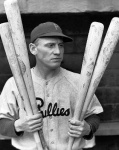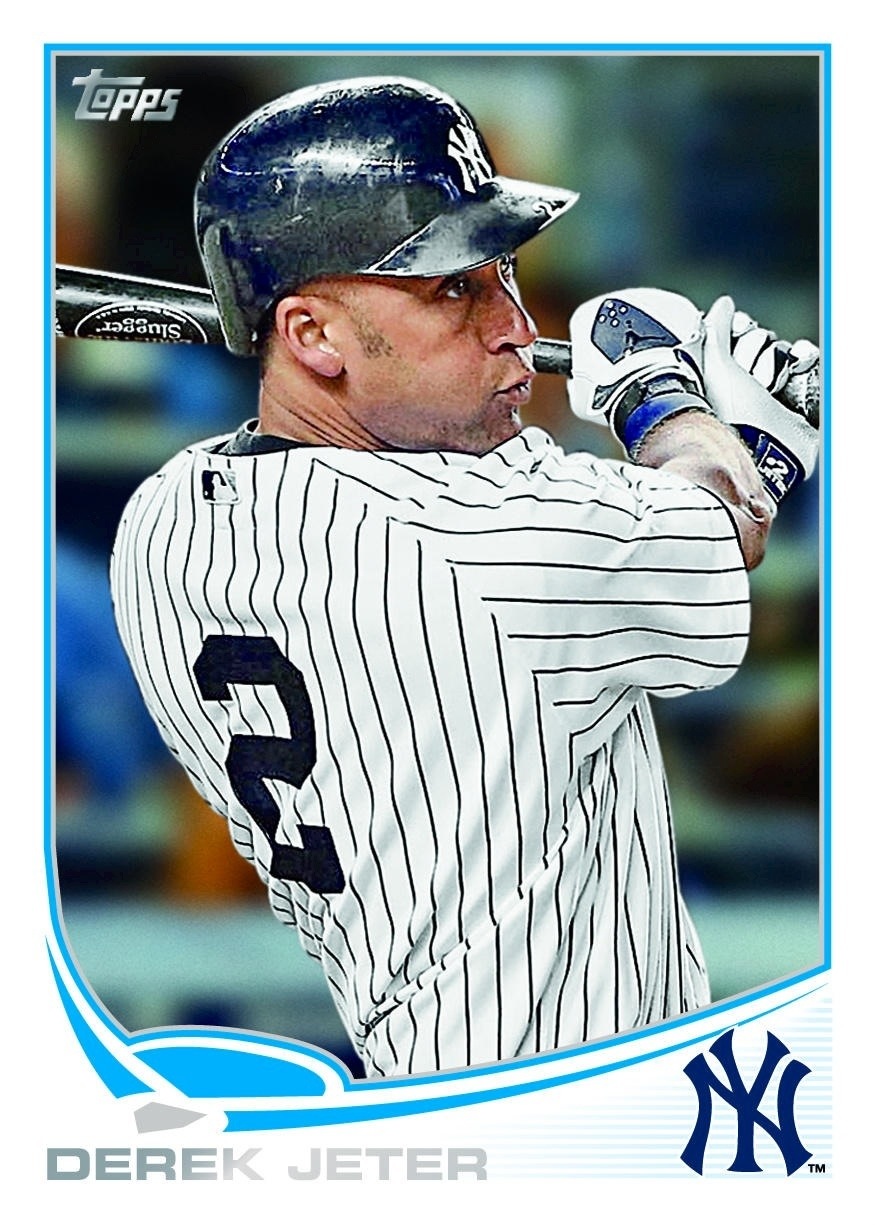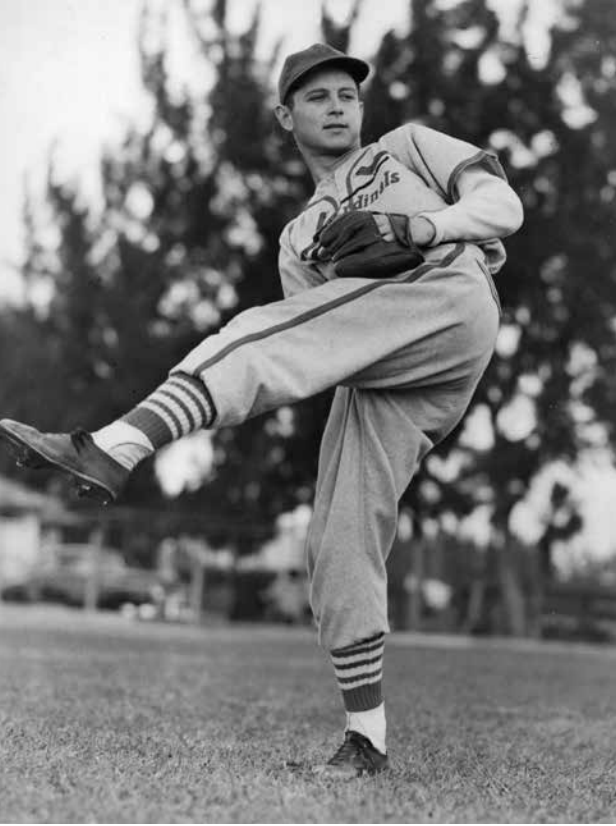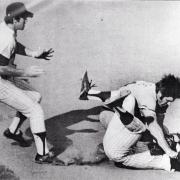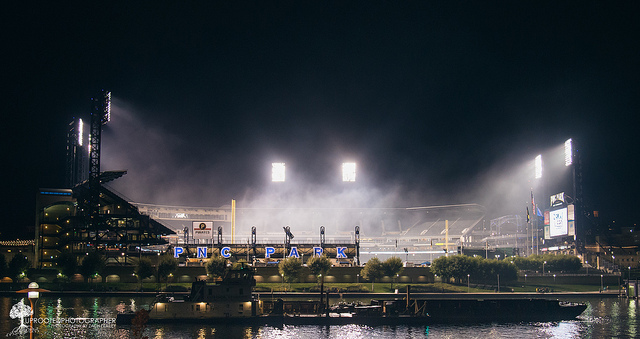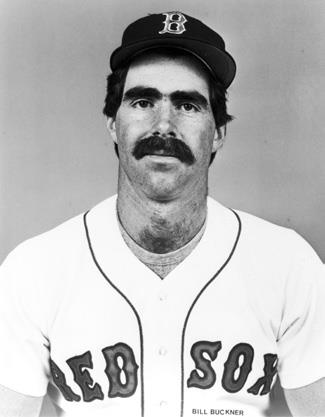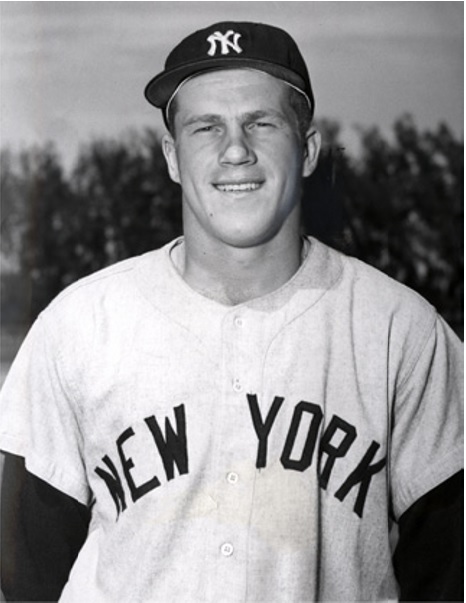October 1, 1932: The Babe calls his shot … or does he?
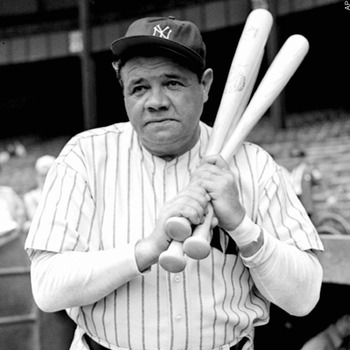 “Keep up the pepper, boys!”1 Chicago manager Charlie Grimm told his team in the clubhouse after the Chicago Cubs’ 7-5 loss to the New York Yankees in Game Three of the 1932 World Series to put the Cubs at a three-games-to-none disadvantage.
“Keep up the pepper, boys!”1 Chicago manager Charlie Grimm told his team in the clubhouse after the Chicago Cubs’ 7-5 loss to the New York Yankees in Game Three of the 1932 World Series to put the Cubs at a three-games-to-none disadvantage.
“You can’t take it away from that pair; they can hit,” said Cubs losing pitcher Charlie Root, who had served up two home runs apiece to Babe Ruth and Lou Gehrig in the game.2 “If I had to do it all over again I’d pitch the same way.”3
“It was a change of pace ball, low and outside,” Root said of the second home run he had yielded to Ruth. “If it had been a fastball I wouldn’t have been surprised. But he picked it out and sent on the line to center field. That convinced me of the power he has in his swings.”4
“We’ll be going home tomorrow,” Babe Ruth bellowed in the joyous New York clubhouse, referring to his expectation of his team winning the next day to wrap up the 1932 World Series.5
“Well I picked a couple of ’em out today anyhow,” Ruth continued, “and I seldom get more fun out of doing it. They’ve got some pretty good bench jockeys on that Cubs bench. But I think I had the last laugh.”6
Before the game Ruth stepped into the batter’s box for his turn during batting practice on a warm Indian summer day, with the temperature reaching an unseasonable 78 degrees. As one might expect, Ruth put on a good show by hammering a half-dozen baseballs over the fences, “and he knew he had the trick for the day,” wrote sportswriter Westbrook Pegler, who also told his readers, “I’m telling you that before the game began the Babe knew he was going to hit one or more homeruns.”7
After slamming the last practice pitch into the far distance, “(H)e waddled toward the Cubs dugout, his large andaman jiggling in spite of his rubber corsets and yelled, ‘You mugs are not going to see Yankee Stadium any more this year. The World Series is going to be over Sunday afternoon, four straight.’”8
He then turned to a group of autograph seekers along the third-base barrier to inform them: “Did you hear what I told them? I told them over there? I told them that they ain’t going back to New York. We lick ’em here, today and tomorrow.”9
“The Babe is on fire,” Lou Gehrig said as he laughed. “He ought to hit one today; maybe a couple.”10 Then the Yankees first baseman, having a poor turn in his batting practice session, focused on himself. “I’m not catching them right, but I know what’s the trouble. I’m catching them on the end of the club. I ought to catch them about four inches down to make ’em ride.”11
Cubs starting pitcher Charlie Root drew the assignment to tame the Yankees in Game Three. A 15-game winner in 1932, he was currently hot, with four wins during the last month of the season. He seemed to start off right by getting New York’s first batter, Earle Combs, to ground one to the shortstop. However, Cubs shortstop Billy Jurges threw the ball away, allowing Combs to take second. Then Root walked the next batter, bringing up Ruth for his first at-bat with runners on first and second.
A salvo of boos greeted Ruth as he paced his way to the plate. Several lemons, thrown from the stands, landed on the field and rolled by Ruth’s feet. He stepped up to the plate and readied himself as he looked out at the Cubs pitcher. Root made his pitch and, “With a step forward, a lurch of his massive shoulders and sweep of his celebrated bat, Ruth drove the ball high into temporary bleachers that had been erected beyond the right field fence. Upward and onward the ball flew, a white streak outlined against the bright blue sky.”12
The top of the first concluded with a 3-0 Yankees lead. When the Yankees took the field in the bottom of the inning, Ruth was greeted by booing from the left-field bleachers. A fan threw a lemon that hit Ruth on the leg. “With graphic gestures, old Mr. Ruth called on them for fair play.”13
The Cubs scored one in their half of the first inning against New York’s starting pitcher, George Pipgras. In the top of the second, Ruth came to the plate with a runner on first and two outs. He got hold of a Root pitch and backed Cubs right fielder Kiki Cuyler up against the screen fence in right. Cuyler made the catch to retire Ruth.
In the top of the third, the score still 3-1, Gehrig came up for his second at-bat. Hoping to fool the Yankees first baseman, Root threw a change-of-pace pitch. Gehrig connected and sent the ball for a long ride into the right-field bleachers. “It wasn’t as far as Ruth’s, and it came with nobody on the bases, but it was just as effective in throwing fear into the hearts of the Cubs.”14
The Cubs, who were not going to go down without a fight, rallied for three runs to tie the game, 4-4, after four innings. In the top of the fifth Ruth led off. “As Ruth came to the plate, swinging three bats over his shoulder, a concerted shout of derision broke in the stands. There was a bellowing of boos, hisses, and jeers. There were cries of encouragement for the pitcher, and from the Cubs dugout came a storm of abuse directed at the Babe.”15
“Ruth, grinning in the face of the hostile greeting, laughed back at the Cubs and took his place, supremely confident.”16
In the Cubs dugout pitchers Guy Bush and Bob Smith, both seated at the top of the dugout steps, were the loudest among the Cubs.
Root’s first pitch sailed by Ruth for a called strike. He responded by holding up one finger as he looked into the Cubs dugout to indicate strike one. “Wait, Mug; I’m going to hit one out of the yard,” he shouted.17 Guy Bush responded by inching up the steps and yelling more insults. Then after two balls, Ruth let another one go by for strike two. Ruth held up two fingers and told the Cubs, “That’s only two strikes, boys. I still have one coming.”18 Bush again responded while scooting closer to the point where he was now sitting on the grass at the edge before the Cubs dugout.
“Then, with a warning gesture of his hand to Bush, he sent the signal for the customers to see, as if to say, ‘Now this is the one, look.’”19
With a count of two balls and two strikes, Root threw his change-of-pace pitch. Ruth swung and “there was a resounding report like the explosion of a gun. The ball soared on a line to center field. Johnny Moore (Cubs center fielder) raced back then stopped and stared.”20
The ball sailed over the center-field fence, passed a flagpole, and dropped into the street. Ruth rounded the bases, and after he passed second base, he slowed down to deliver a message to Bush and the Cubs in the Chicago dugout. “The Yankees spilled out of the dugout and danced with glee. They moved forward to shake Ruth’s hand and pat him on the back.”21
As the Yankees continued to talk about Ruth’s home run, Gehrig hit a high curveball and sent it for a ride into the right-field bleachers for his second homer of the game. The score was now 6-4 in favor of the Yankees.
In the bottom of the ninth, with the Yankees nursing a two-run lead, a runner on first and Rollie Hemsley at the plate for the Cubs, Guy Bush, who was warming up in the left-field bullpen, shouted advice for the Yankees left fielder. “Say Babe, don’t you know that Hemsley is a left-field hitter? You better come over close to the foul line.”22
“Well, if that’s true, I will,” responded Ruth, who then walked to his right until he was 12 feet from the left-field foul line. “Is this the right spot?” asked Ruth.23
Bush assured him that it was.
Hemsley struck out, the next batter grounded out, and then Cubs third baseman Woody English grounded out to end the game. “Well, I’ll see you tomorrow, Joe,”24 Ruth told Bush, and then jogged toward the infield.
An angry look then came across Bush’s features: not because Ruth called him by the wrong name. He tried his best, but he was unable to get Ruth’s goat that day.
Notes
1 Chicago Tribune, October 2, 1932.
2 Chicago Tribune, October 2, 1932.
3 Chicago Tribune, October 2, 1932.
4 Chicago Tribune, October 2, 1932.
5 Chicago Herald American, October 2, 1932.
6 Ibid.
7 Chicago Tribune, October 2, 1932.
8 Chicago Tribune, October 2, 1932.
9 Chicago Tribune, October 2, 1932.
10 Chicago Tribune, October 2, 1932.
11 Chicago Tribune, October 2, 1932.
12 New York Herald-Tribune, October 2, 1932.
13 Chicago Tribune, October 2, 1932.
14 New York Herald-Tribune, October 2, 1932.
15 New York Herald-Tribune, October 2, 1932.
16 New York Herald-Tribune, October 2, 1932.
17 Chicago Tribune, October 2, 1932.
18 Chicago Tribune, October 2, 1932.
19 Chicago Tribune, October 2, 1932.
20 New York Herald-Tribune, October 2, 1932.
21 New York Herald-Tribune, October 2, 1932.
22 Chicago Tribune, October 2, 1932.
23 Chicago Tribune, October 2, 1932.
24 Chicago Tribune, October 2, 1932.
Additional Stats
New York Yankees 7
Chicago Cubs 5
Game 3, WS
Wrigley Field
Chicago, IL
Box Score + PBP:
Corrections? Additions?
If you can help us improve this game story, contact us.


